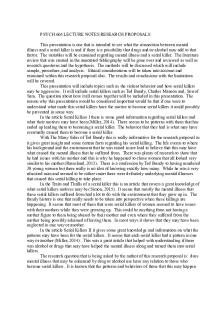Psych Correlation/Differential/Experimental Research PDF

| Title | Psych Correlation/Differential/Experimental Research |
|---|---|
| Author | Erin Aduna |
| Course | Research Methods In Psychology. |
| Institution | Montclair State University |
| Pages | 3 |
| File Size | 100.9 KB |
| File Type | |
| Total Downloads | 55 |
| Total Views | 135 |
Summary
Correlation/Differential/Experimental Research
Experimental Hypotheses:Dependent-Samples t-Test:
Differential Hypotheses:One-Sample t-Test:
DifferentialResearch:Comparing pre-existing groups of participants....
Description
PSYCH 203 Montclair State University Spring 2017 Notes #6 _________________________________________________________________________________________________________
Correlational Research: Correlation is any of a broad class of statistical relationships involving association, though in common usage it most often refers to the extent to which two variables have a linear relationship with each other. Familiar examples of dependent phenomena include the correlation between the physical statures of parents and their offspring, and the correlation between the demand for a product and its price. Correlations are useful because they can indicate a predictive relationship that can be exploited in practice. Correlation does not imply causation! Only association can be drawn. Not as powerful as an experimental design. r coefficient: Quantitative range: -1 ≤ r ≤ 1 Properties: Magnitude/Strength: absolute distance from zero Direction: positive or negative Possible relationship(s) between variables: Positive linear relationship Negative linear relationship Curvilinear relationship No relationship _________________________________________________________________________________________________________
Correlational Hypotheses: Is there a significant relationship (i.e., positive or negative) between two variables? H 0: r=0 H 1: r≠0 _________________________________________________________________________________________________________
_________________________________________________________________________________________________________
Differential Research: Comparing pre-existing groups of participants. The setting is typically highly constrained and the measurement procedure must be carefully defined and precisely followed. _________________________________________________________________________________________________________
Differential Hypotheses: One-Sample t-Test: Is the sample distribution (i.e., one group) significantly different from the population distribution on the one variable measured?
H0: H1:
µ1 = a known parameter within the population (e.g., IQ mean µ = 100) µ1 ≠ a known parameter within the population (e.g., IQ mean µ = 100)
Independent-Samples t-Test: Is there a significant difference between two sample distributions (i.e., groups) on one variable measured?
H0: H1:
µ1 = µ2 µ1 ≠ µ2
or µ1 - µ2 = 0 or µ1 - µ2 ≠ 0 _________________________________________________________________________________________________________
_________________________________________________________________________________________________________
Experimental Research: The control and direct manipulation of variables (i.e., all extraneous variables are kept constant thus they cannot confound the experiment). Randomization (i.e., random assignment) is a key defining factor (i.e., eliminating extraneous variables’ contribution). The independent variable (i.e., cause) is manipulated (e.g., weight loss drug). The dependent variable (i.e., effect) is not manipulated. Changes are made to the independent variable then the dependent variable is observed to see if it has changed/altered. The type of research design allows for cause and effect relationships to be established/determined. An experiment is a procedure carried out to support, refute, or validate a hypothesis. Experiments provide insight into cause-and-effect by demonstrating what outcome occurs when a particular factor is manipulated. Experiments vary greatly in goal and scale, but always rely on repeatable procedure and logical analysis of the results. Experiments can vary from personal and informal natural comparisons (e.g. tasting a range of chocolates to find a favorite), to highly controlled (e.g. tests requiring complex apparatus overseen by many scientists that hope to discover information about subatomic particles). Uses of experiments vary considerably between the natural and human sciences. Experiments typically include controls, which are designed to minimize the effects of variables other than the single independent variable. This increases the reliability of the results, often through a comparison between control measurements and the other measurements. Scientific controls are a part of the scientific method. Ideally, all variables in an experiment are controlled (accounted for by the control measurements) and none are uncontrolled. In such an experiment, if all controls work as expected, it is possible to conclude that the experiment works as intended, and that results are due to the effect of the tested variable. _________________________________________________________________________________________________________
Experimental Hypotheses: Dependent-Samples t-Test: Is the mean D score distribution (i.e., pre-post) significantly different from zero?
H0: H1:
D = 0 (where D is the difference between two means (i.e., pre - post)) D≠0 _________________________________________________________________________________________________________...
Similar Free PDFs

Psych
- 54 Pages

Psych 9
- 3 Pages

Memory Psych
- 1 Pages

developmental psych
- 6 Pages

Psychophysics - Psych
- 2 Pages

Research(draft 3) - research
- 16 Pages

Psych 10
- 2 Pages

Psych Medication
- 1 Pages
Popular Institutions
- Tinajero National High School - Annex
- Politeknik Caltex Riau
- Yokohama City University
- SGT University
- University of Al-Qadisiyah
- Divine Word College of Vigan
- Techniek College Rotterdam
- Universidade de Santiago
- Universiti Teknologi MARA Cawangan Johor Kampus Pasir Gudang
- Poltekkes Kemenkes Yogyakarta
- Baguio City National High School
- Colegio san marcos
- preparatoria uno
- Centro de Bachillerato Tecnológico Industrial y de Servicios No. 107
- Dalian Maritime University
- Quang Trung Secondary School
- Colegio Tecnológico en Informática
- Corporación Regional de Educación Superior
- Grupo CEDVA
- Dar Al Uloom University
- Centro de Estudios Preuniversitarios de la Universidad Nacional de Ingeniería
- 上智大学
- Aakash International School, Nuna Majara
- San Felipe Neri Catholic School
- Kang Chiao International School - New Taipei City
- Misamis Occidental National High School
- Institución Educativa Escuela Normal Juan Ladrilleros
- Kolehiyo ng Pantukan
- Batanes State College
- Instituto Continental
- Sekolah Menengah Kejuruan Kesehatan Kaltara (Tarakan)
- Colegio de La Inmaculada Concepcion - Cebu







